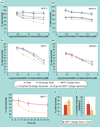Enhanced binding and killing of target tumor cells by drug-loaded liposomes modified with tumor-specific phage fusion coat protein
- PMID: 20528452
- PMCID: PMC2914609
- DOI: 10.2217/nnm.10.30
Enhanced binding and killing of target tumor cells by drug-loaded liposomes modified with tumor-specific phage fusion coat protein
Abstract
Aim: To explore cancer cell-specific phage fusion pVIII coat protein, identified using phage display, for targeted delivery of drug-loaded liposomes to MCF-7 breast cancer cells.
Material & methods: An 8-mer landscape library f8/8 and a biopanning protocol against MCF-7 cells were used to select a landscape phage protein bearing MCF-7-specific peptide. Size and morphology of doxorubicin-loaded liposomes modified with the tumor-specific phage fusion coat protein (phage-Doxil) were determined by dynamic light scattering and freeze-fraction electron microscopy. Topology of the phage protein in liposomes was examined by western blot. Association of phage-Doxil with MCF-7 cells was evaluated by fluorescence microscopy and fluorescence spectrometry. Selective targeting to MCF-7 was shown by FACS using a coculture model with target and nontarget cells. Phage-Doxil-induced tumor cell killing and apoptosis were confirmed by CellTiter-Blue Assay and caspase-3/CPP32 fluorometric assay.
Results: A chimeric phage fusion coat protein specific towards MCF-7 cells, identified from a phage landscape library, was directly incorporated into the liposomal bilayer of doxorubicin-loaded PEGylated liposomes (Doxil) without additional conjugation with lipophilic moieties. Western blotting confirmed the presence of both targeting peptide and pVIII coat protein in the phage-Doxil, which maintained the liposomal morphology and retained a substantial part of the incorporated drug after phage protein incorporation. The binding activity of the phage fusion pVIII coat protein was retained after incorporation into liposomes, and phage-Doxil strongly and specifically targeted MCF-7 cells, demonstrating significantly increased cytotoxicity towards target cells in vitro.
Conclusion: We present a novel and straightforward method for making tumor-targeted nanomedicines by anchoring specific phage proteins (substitute antibodies) on their surface.
Conflict of interest statement
The authors have no other relevant affiliations or financial involvement with any organization or entity with a financial interest in or financial conflict with the subject matter or materials discussed in the manuscript apart from those disclosed.
No writing assistance was utilized in the production of this manuscript.
Figures






References
-
-
Peer D, Karp JM, Hong S, Farokhzad OC, Margalit R, Langer R. Nanocarriers as an emerging platform for cancer therapy. Nat. Nanotechnol. 2007;2:751–760. • Describes the potential of nanotechnology in revolutionizing cancer diagnosis and therapy.
-
-
-
Alexis F, Rhee JW, Richie JP, Radovic-Moreno AF, Langer R, Farokhzad OC. New frontiers in nanotechnology for cancer treatment. Urol. Oncol. 2008;26:74–85. • Discusses recent advances of cancer nanotechnology with particular attention to nanoparticle systems that are in clinical practice or in various stages of development for cancer imaging and therapy.
-
-
- Sofou S. Surface-active liposomes for targeted cancer therapy. Nanomedicine (Lond.) 2007;2(5):711–724. - PubMed
-
- Noble CO, Kirpotin DB, Hayes ME, et al. Development of ligand-targeted liposomes for cancer therapy. Expert Opin. Ther. Targets. 2004;8:335–353. - PubMed
Publication types
MeSH terms
Substances
Grants and funding
LinkOut - more resources
Full Text Sources
Other Literature Sources
Research Materials
Miscellaneous
